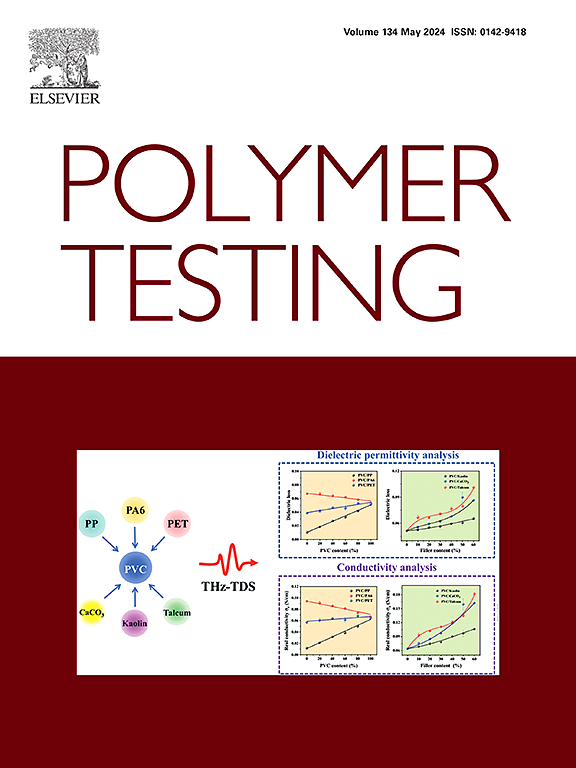Rate-dependent cohesive zone modeling and experimental validation for viscoelastic sensor-embedded interfaces
IF 5
2区 材料科学
Q1 MATERIALS SCIENCE, CHARACTERIZATION & TESTING
引用次数: 0
Abstract
The mechanical behavior of viscoelastic interfaces in sensor-embedded systems exhibits strong rate dependence, directly influencing adhesion performance and structural integrity. Existing cohesive zone models (CZMs) inadequately capture the interplay between viscoelastic bulk deformation and interfacial damage evolution, particularly under dynamic loading. This study proposes a novel rate-dependent CZM framework integrating viscoelastic liner mechanics to decouple bulk deformation from true interfacial behavior. A trilinear stress-strain relationship (weak/strong nonlinear strengthening and damage softening) was identified through multi-rate uniaxial tensile experiments on polyimide (PI)/hydroxyl-terminated polybutadiene (HTPB) interface specimens. Key innovations include a methodology to isolate interfacial cohesion parameters via Prony series-based viscoelastic decoupling and finite element validation. Results demonstrate exponential rate dependence of cohesive strength (1.19–1.58 MPa) and critical displacement (0.89–0.67 mm) across 10–70 mm/min loading rates, with stress intensification during damage propagation. The model aligns closely with experiments at low strain rates, while discrepancies at high rates highlight viscoelastic relaxation effects. This work advances interface mechanics by resolving the coupling of bulk and interfacial responses, offering a universal framework for adhesion analysis in flexible sensor systems.
粘弹性传感器内嵌界面速率相关内聚区建模及实验验证
传感器嵌入式系统中粘弹性界面的力学行为表现出强烈的速率依赖性,直接影响粘附性能和结构完整性。现有的黏结区模型(CZMs)不能充分反映粘弹性体变形和界面损伤演化之间的相互作用,特别是在动载荷下。本研究提出了一种新的速率相关的CZM框架,将粘弹性衬垫力学与实际界面行为分离开来。通过多速率单轴拉伸试验,确定了聚酰亚胺(PI)/端羟基聚丁二烯(HTPB)界面试样的三线性应力-应变关系(弱/强非线性强化和损伤软化)。关键的创新包括通过基于proony序列的粘弹性解耦和有限元验证分离界面粘聚参数的方法。结果表明,在10 ~ 70 mm/min加载速率下,黏结强度(1.19 ~ 1.58 MPa)和临界位移(0.89 ~ 0.67 mm)呈指数关系,损伤扩展过程中应力加剧。该模型在低应变率下与实验密切相关,而在高应变率下的差异突出了粘弹性松弛效应。这项工作通过解决体和界面响应的耦合来推进界面力学,为柔性传感器系统中的粘附分析提供了一个通用框架。
本文章由计算机程序翻译,如有差异,请以英文原文为准。
求助全文
约1分钟内获得全文
求助全文
来源期刊

Polymer Testing
工程技术-材料科学:表征与测试
CiteScore
10.70
自引率
5.90%
发文量
328
审稿时长
44 days
期刊介绍:
Polymer Testing focuses on the testing, analysis and characterization of polymer materials, including both synthetic and natural or biobased polymers. Novel testing methods and the testing of novel polymeric materials in bulk, solution and dispersion is covered. In addition, we welcome the submission of the testing of polymeric materials for a wide range of applications and industrial products as well as nanoscale characterization.
The scope includes but is not limited to the following main topics:
Novel testing methods and Chemical analysis
• mechanical, thermal, electrical, chemical, imaging, spectroscopy, scattering and rheology
Physical properties and behaviour of novel polymer systems
• nanoscale properties, morphology, transport properties
Degradation and recycling of polymeric materials when combined with novel testing or characterization methods
• degradation, biodegradation, ageing and fire retardancy
Modelling and Simulation work will be only considered when it is linked to new or previously published experimental results.
 求助内容:
求助内容: 应助结果提醒方式:
应助结果提醒方式:


